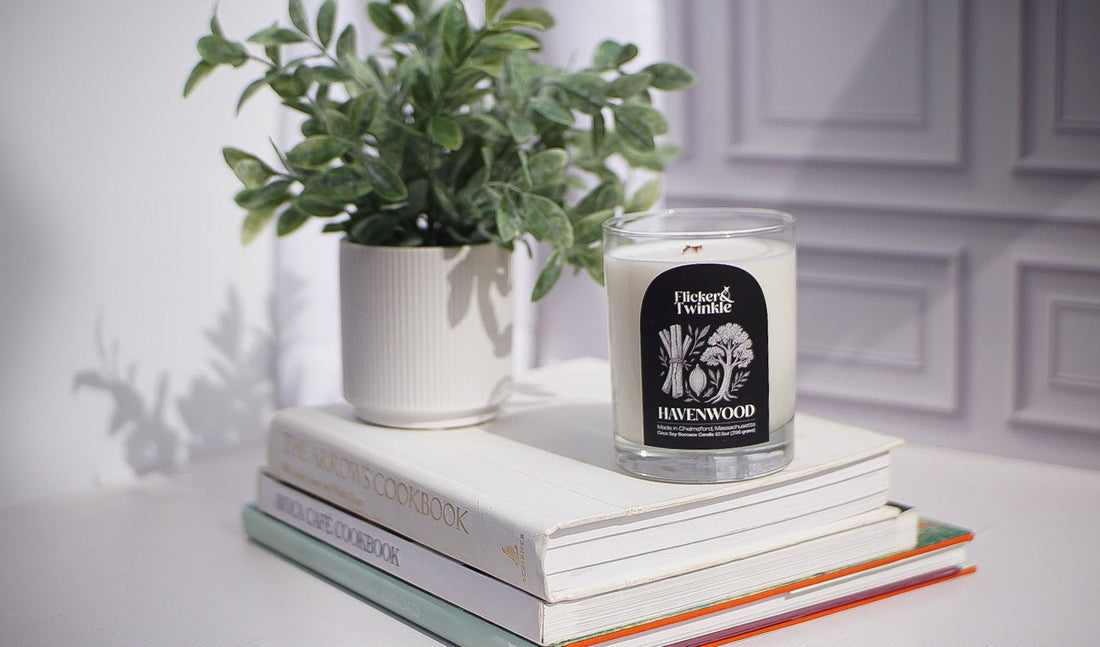
Coconut Wax vs. Soy Wax – Which Is Better for Candles?
updated September 2025
How Different Candle Waxes Perform (and Why Blends Win)
If you’ve ever stood in front of a candle display wondering which wax really makes the “best” candle, you’re not alone. Coconut, soy, beeswax, paraffin—there’s a lot of buzz (and a lot of marketing). At Flicker & Twinkle, we’ve tested it all, and after years of pouring, burning, and tweaking, we landed on our own custom coconut–soy–beeswax blend.
Why? Because no single wax gave us the burn, the throw, and the performance we wanted. Each has its strengths and weaknesses—so we blended the best of all three. AND, because as my mom always says, I like to make life harder on myself 😂
Here’s the breakdown.
Coconut Wax: The Star of the Show
Coconut wax is known for one thing above all else: its hot throw. That’s candle-speak for how well the fragrance projects when lit. While soy candles can smell strong “on cold” (cold throw = unlit), coconut wax shines once the flame is on. Its hot throw fills a room in minutes, making it the clean-wax rival to paraffin when it comes to performance.
It’s also smooth, creamy, and burns cooler than most waxes—helping extend the life of your candle. Among clean-burning waxes, coconut is practically unmatched for hot throw projection.
Soy Wax: The Balancer
So why not just pour 100% coconut? Two reasons: texture and balance. Pure coconut wax is too soft to stand on its own, and it requires tiny wicks that drown near the end of the jar. Plus, its cold throw is weaker—meaning customers can’t really smell it on the shelf.
Soy helps solve both problems. It firms up the texture, supports wick performance, and adds that strong cold throw so you can smell the candle right from the jar. The tradeoff? Pure soy can tunnel, frost, and reset unevenly unless additives are used. But in a blend, it gives structure without overpowering.
Beeswax: The Secret Weapon
Beeswax is the densest of the three, and even at 5–10% it makes a huge difference. It slows the burn, extending the life of your candle by 10–20%. It also strengthens wick performance, allowing us to size up flames for double wicks or wood wicks without drowning. Bonus: beeswax makes the crackle on our wood wicks even better.
This tiny addition gave us the sweet spot—longer burn time, steadier flames, and a more reliable burn.
Why We Don’t Use Paraffin
When customers come into our pop-ups, one of the first questions we hear is: “Is this a clean candle?” To us, that meant building a formula that’s 100% paraffin-free. Paraffin can throw scent like a powerhouse, but it’s not what our customers want in their homes.
Our fragrances are always phthalate-free as well, because clean-burning isn’t just about the wax—it’s about the whole formula.
Why Wicking Matters (and How We Nail It)
No matter how good your wax blend is, if the wick is wrong, the candle is ruined. Overwicked candles burn too hot, produce soot, and make jars scorch to the touch. Underwicked candles drown halfway and won’t stay lit.
At Flicker & Twinkle, we’re meticulous with wick testing. Every jar goes through rounds of burns until it hits the Goldilocks zone—no soot, no overheating, just a steady flame with minimal trimming.
Pro Tip:
-
Black soot? It’s overwicked.
-
Flame keeps drowning? It’s underwicked.
Because being a chandler isn’t confusing enough 🙃
What “Clean Candle” Really Means
Here’s the deal: no candle can honestly be labeled 100% “non-toxic.” Burning anything—even a blade of grass—releases compounds into the air. So when you see brands claiming it? That’s marketing fluff dressed up as science.
What we can say: our blend is paraffin-free, our fragrance oils are phthalate-free, and we use high-end fragrance blends made from clean synthetics and essential oils. Why both? Because not all essential oils are safe when set on fire. Some have low flash points (fire hazards) and some can irritate pets or affect indoor air quality.
By combining safe synthetics with naturals, chemists create fragrance compounds that burn cleanly, smell authentic, and are safer for your home. That’s why our scents are balanced, layered, and designed for real performance—never flat, never overly sweet.
And one last PSA: there’s no such thing as vanilla essential oil. If a brand says they’re “essential oil only” but their candle smells like vanilla cake, they’re greenwashing you.
Why Luxury Candles Are Different
Luxury candles aren’t just about the jar (though ours are stunning in USA-made Libbey highball glassware). What sets them apart is the way they perform.
Our fragrance profiles are carefully balanced powerhouses—never one-note, never cloying, always layered with personality. Pair that with our coconut–soy–beeswax blend, meticulous wicking, and natural wood wicks in a signature X-pattern, and you’ve got a candle that burns clean, projects beautifully, and looks incredible while doing it.
✨ Ready to experience the difference?
👉 Shop our Coconut–Soy–Beeswax Candles here
